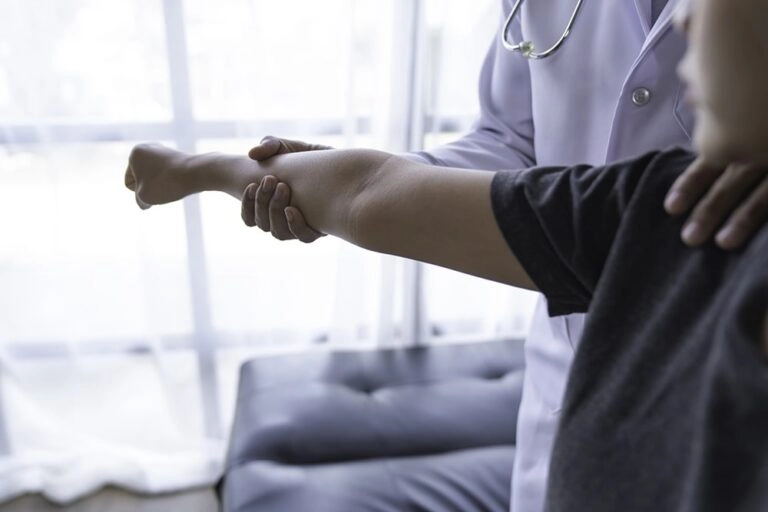Is It Safe to Visit a Chiropractor during Pregnancy?

We believe that it is extremely important, to both you and your baby, that you receive regular chiropractic care through your entire pregnancy. Most chiropractors have observed that pregnant women feel much better during their pregnancy with regular visits to a chiropractor. The ones who receive regular chiropractic care seem to have easier and quicker deliveries.
To date, there are no known risk concerns to chiropractic care throughout pregnancy. Basically, all doctors of chiropractic are formally educated to work with expectant women. However, it is up to the mother-to-be to choose chiropractors who are members of the American Chiropractic Association, who are bounded by a code of ethics.
According to a research, 50% of all expectant women suffer back pain during their pregnancy period. 50 to 75% of the women suffer back pain through labor as well as delivery. 21% of the women seek medical care regarding neck pain. These statistics may not be perfect, but they indicate the need for chiropractic during pregnancy.
Chiropractor Pregnancy Risks
Is chiropractic safe when pregnant? Yes, most definitely! Misconceptions do exist that chiropractic care is risky for pregnant women. However, chiropractors are trained on how to use careful practice with pregnancy patients.
Technically, there is no real risk of chiropractic care during pregnancy. There are so many mothers that go along with other unsafe medical protocols, which have statistically caused a significant number of birth traumas.
Chiropractic care has proven to be very effective at treating birth traumas and helping children with sensory disorders. Therefore, the same manipulative care can help the mother and the child avoid deliveries with birth traumas attached.
Chiropractor Pregnancy Risks
Pinched nerves may be caused by subluxations and other musculoskeletal and neuromuscular conditions. Many of the causes can be managed with spinal manipulation procedures.
Many chiropractic methods are focused on finding pinched nerves. By feeling the vertebrae and the surrounding muscles, the doctor works to detect affected parts. A joint that does not move as freely as it should is a clear sign of nerve impingement.
Chiropractic treatment is exceptionally helpful in curing a pinched nerve. This condition normally involves an impingement. Therefore, there must be a joint pressing on the affected nerve. This can include tight muscles, a herniated disc, or a bulging disc.
With a pinched nerve, you should expect the pain to radiate, since it does not always remain local. For instance, a pinched nerve in your lumbar area can radiate pain into your leg. A nerve in your neck can radiate pain into your arm.
A doctor of chiropractic can help you treat the condition by moving the bones into their correct positions in order to relax the muscles and eliminate the pressure exerted on nerves. You can receive treatment for a pinched nerve and any other associated symptoms without surgery.
A few techniques used are:
- Flexion-distraction technique
- Massage therapy
Flexion-distraction therapy
This is a treatment that alleviates neck and back pain caused by a pinched nerve, sciatica, and disc herniation. This method consists of a special table that features bending, extending, and flexing procedures, which enable the chiropractor to make the needed adjustments.
Most studies consider flexion-distraction to be a staple chiropractic solution, which does an amazing job of treating the patient’s vertebral column in order to promote pain relief. This method gives the doctor control of the spine during therapy.
Flexion-distraction technique is what most chiropractors will recommend for a pinched nerve and the associated ailments, including neck pain, leg pain, stenosis, headaches, arm pain, and whiplash.
Benefits of Flexion-Distraction Therapy
- Decreases annular tension exerted on annular nerves and fibers
- Increases the height of the intervertebral disc to increase circulation
- Ensures the nucleus pulpous recovers its central position within the fibers
- Gets rid of irritation in the spinal nerve
- Helps return the vertebral joints to their original healthy motion
- Relieves pain and improves posture and motion
Massage Therapy
Can a massage help a pinched nerve?
It is advisable to handle the problem while it is mild. This way, you can engage alternative treatment options, such as massage therapy. Your visit to a chiropractor may include massage therapy as one of the options. Treating pain conditions early helps to minimize the risk of chronic pain.
One good thing about massage therapy is that no surgery is involved. It offers pain relief and muscle relaxation further helping the body to promote its own recovery. Massage therapy helps to focus mainly on the pinched nerve area.
You can also prevent the development of a pinched nerve with the following:
- Infrared massaging devices: Uses infrared technology to reach the deep muscle tissues for quick results.
- Infrared heating pads: Uses infrared technology to take apart pinched nerves and promote blood flow.
- Cervical traction devices: Helps to readjust the cervical spine from the neck downwards.
From the points we have highlighted above, it is clear that massage therapy is a reliable alternative for treating and preventing the condition. Consulting a chiropractic massage therapist helps increase recovery efforts and improve results.
Pinched nerves can cause real pain but patients know they can rely on Better Health Chiropractic Juneau’s Get-A-Ride promise which ensures they will get to and from their chiropractic appointment without any cost to them. Visit our page to book an appointment.
Chiropractor Pregnancy Pelvic Pain
Pelvic pain or pelvic instability involves the bones, muscles, and the nervous system of the pelvis as well as the lower back. Even though the pelvis appears to be a fixed circle of bone, it is made up of three separate bones that are joined together. The involved bones include two hipbones, the backbone in the lower spine, and the tailbone.
The involved joints are: the public joint, which connects both hipbones on the front side; and the two joints in the lower back on either side of the sacrum, referred to as the sacroiliac joints. The bones form a ring that is held together with cartilage and ligaments, which relax and stretch in response to hormonal changes during pregnancy.
This leads to the lengthening as well as weakening of the ligaments of the pelvic joints, the surrounding muscles, and the connective fascia, which all provide stability to the pelvic ring. The abovementioned activities may cause the bones to shift and become misaligned, resulting in pain and interfering with the ability to move properly.
The fact that the musculoskeletal system is interrelated means that the misalignment may affect the entire body. There are a number of simple movements that may be difficult and painful, including: reaching to put things away, getting out of bed in the morning, and moving from sitting to standing.
Who Experiences Pelvic Pain During Pregnancy?
Pelvic pain due to unstable pelvis is a normal condition during pregnancy, which is considered a useful condition that facilitates delivery. Women who swam a lot during their youth may present more complaints than other people. Pelvic pain is also common for women who experienced low back pain before pregnancy.
Signs of Pelvic Pain
Most women who have pelvic problems complain of continuous pain. The pain may be sharp, burning, or sore. It usually focuses on and around the pelvic area. The associated areas are the pelvic bone; the groin; the back or the sides of the thighs; the lower back, the stomach; and the tailbone.
The pain can radiate down into the legs, upward into the back, and sometimes into the neck. One of the most annoying aspects of the pain is that it keeps on changing. It can be intense, and it can disappear suddenly. This makes a pregnant woman feel confused and unsure. Here are the major signs you should look out for:
- Digestive problems
- Pain while urinating or defecating
- Bloating
- Incontinence
- Back pain
What a Chiropractor Can Do for Pelvic Pain and Other Related Issues during Pregnancy
Doctors of chiropractic see more than one cause of pelvic instability in pregnancy. The two main causes they see are diastasis symphysis pubis (DSP) and symphysis pubis dysfunction (SPD). Chiropractic care is very effective for pelvic instability; not to mention that it is natural and safe. Chiropractors do not involve the use of medication during pregnancy.
A chiropractor will conduct a full-body exam and take a detailed medical history prior to any chiropractic treatment plan. The chiropractic treatment may include:
- Evaluation of the pelvic pain
- Work on the affected muscles and ligaments
- Diaphragmatic release
- Active release techniques
- Ultrasound and laser therapy
- Application of ice
- Webster’s technique
- Activator techniques
- Blocking techniques
- Endorse the use of a sacroiliac stability belt
- Exercise advice
Diaphragmatic Release
Proper Diaphragmatic Release will eliminate possible problems with motion sickness, breathing, oxygen levels, and blood flow to the mother and the baby. This chiropractic procedure helps to relax the broad ligament, giving the baby more room to take the labor position. This is a subtle technique that uses the lightest touch possible.
Active Release Techniques (ART)
This is a non-forceful approach used by chiropractors to relieve sacral pain and low back pain during pregnancy. It is a musculoskeletal approach that does not constitute any vertebral adjustment. The manipulative doctor uses a combination of tissue motion and digital pressure to selectively stretch precise soft tissue parts that cause pain and discomfort.
Webster’s Technique
This is a type of chiropractic care that focuses on reducing strain on ligaments supporting the uterus, as well as improving pelvic alignment, which may encourage the baby to flip. It is the recommended technique to be used throughout pregnancy by a chiropractor.
The Webster’s Technique is well-defined as a definite chiropractic examination and adjustment that decreases interference to the nerve system as well as facilitates biomechanical balance in ligaments, muscles, and pelvic structures.
The technique leads to the removal of torsion (the tension on the muscles and ligaments which cause intrauterine constraint and prevents the baby from comfortably assuming the best possible position in preparation for birth) to the uterus, reducing any constraint to the baby.
Chiropractor Pregnancy Sciatica
Sciatica is severe pain, weakness, or numbness of the lower back, buttocks, and thighs that radiate from the side of the thigh to the front of the lower leg. This pain is normally concentrated on one side of the body. Sciatica can be mild, but patients are usually very uncomfortable.
As pregnancy progresses, baby grows larger and eventually presses its head into the mother’s pelvis. As a result, the pelvic bone undergoes great pressure, despite the fact that the pelvis shifts to house the baby. The pelvic pressure may actually stretch the sciatic nerves, which are located in the back and buttocks.
Stretching or pressure on the sciatic nerve causes intense pain, weakness, and numbness. Sciatica is not an easy thing to live with, but chances are it will clear up before delivery if you seek the help of a chiropractor. If you are in Anchorage, Alaska, schedule a chiropractic appointment with us at Better Health Chiropractic to see what your non-surgical options are today.
A sciatica treatment plan in pregnancy may include ice/cold therapies, ultrasound, and spinal manipulation. Ice/cold therapies help to control sciatic pain by reducing inflammation. Ultrasound helps to increase circulation as well as reduce pain, muscle spasms, stiffness, swelling, and cramping.
Manipulation of the spine releases restricted spinal movements in order to restore misaligned vertebrae to their original position. Spinal manipulation may combine gentle pressure and minimal force. Many pregnant women have benefited from a chiropractic adjustment to relieve sciatica and lower back pain due to pregnancy.
A chiropractic adjustment is safe for a pregnant woman and her baby and can be especially useful to those who are trying to avoid unnecessary medication in treating sciatica and lower back pain. A number of good investigations offer increasing evidence that manipulative care is helpful to pregnant women and their unborn babies.
In Conclusion
During pregnancy, chiropractic care may assist to:
- Reduce pelvic and spinal discomfort and tension
- Reduce labor time and make delivery easy
- Improve your body’s overall health and wellbeing
- Improve your capacity to cope with stress
- Increase your ability to exercise comfortably
In the event of a breech birth, some chiropractors are trained in the Webster’s Technique and may treat women to create the optimum environment for the baby to turn. This is one of the many things women can try.
The safety of chiropractic during pregnancy is a major concern for most people. However, the American Pregnancy Association views chiropractic care as a safe therapy for women during pregnancy. According to modern science, chiropractic is considered an effective and safe way of handling common musculoskeletal problems that affect pregnant women. Prepare yourself early to enjoy holding your new baby without hurting your back.
Schedule an Appointment and Receive
FREE One-Hour Massage Certificate
That’s right! Receive a certificate for a free one-hour massage with our highly-trained and licensed massage therapists for use after your first appointment. Use it yourself, or give it to a friend.

About the Author
Dr. Brent Wells has been a trusted chiropractor since moving his family from Oregon to Alaska back in 1998 and founded Better Health Alaska – B.S. from Univ. of Nevada, Doctorate from Western States Chiropractic College, volunteer for Reflex Sympathetic Dystrophy Foundation, and member of the American Chiropractic Association. As a chiropractor his focus is on family, including his 3 children and wife of 20+ years, his clinics, and ongoing education.
Related Posts
Featured Posts
Evidence-Based Treatments for Arthritis in Anchorage, AK
Treatment Options for Shoulder Pain in Anchorage, AK
Knee Pain Treatment Options in Anchorage, Alaska
NEWSLETTER SIGN-UP
Sign up now!
South Anchorage
- 8840 Old Seward Hwy E, Anchorage, Alaska 99515
- Phone: 907-346-5255
- Open Hours: 9AM to 7PM













